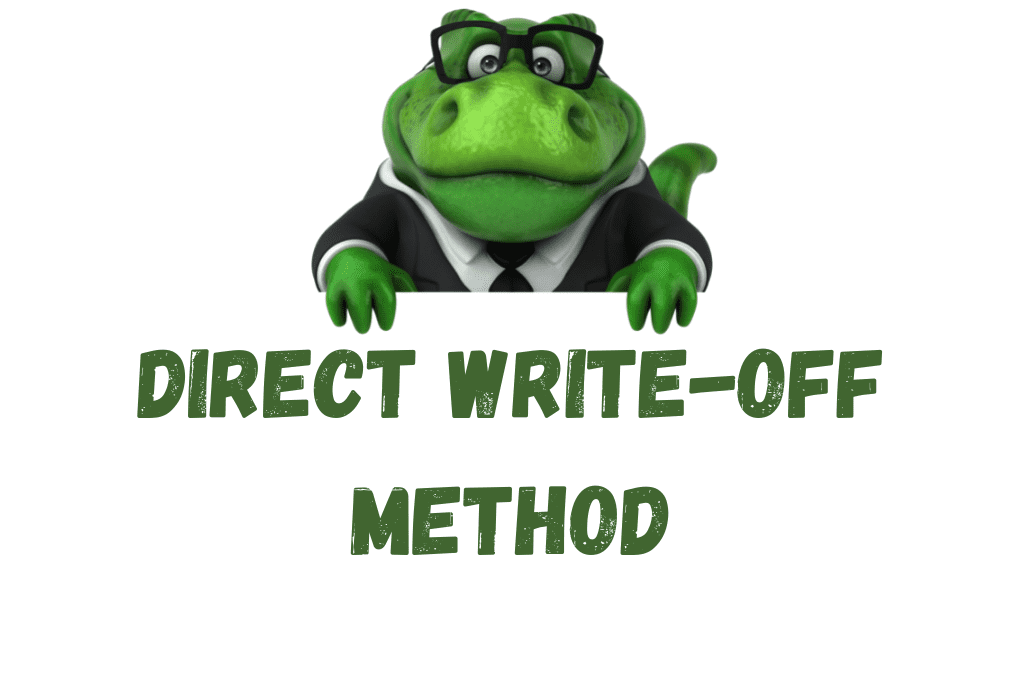The direct write-off method for bad debts is a method used by smaller companies with few receivables. Debts are written-off at the time the debt is determined to be uncollectible.
When is the Direct Write-off Method Used?
The Direct Write-off Method is used by smaller companies and those with only a few receivables accounts. Because it does not conform to GAAP, larger companies and those companies with many receivables accounts cannot use this method. Accounts are written-off at the time the debt is determined to be uncollectible.
Examples of businesses that could potentially use the Direct Write-off Method are businesses that don’t offer credit, receiving all or most payments at the time of sale: restaurants, grocery stores, online businesses. Because the risk of bad debts is minimal, a business does not have to estimate future bad debts.
What is the Journal Entry for Direct Write-off of a Bad Debt?
When an account is determined to be uncollectible, a company will do a journal entry to debit (increase) Bad Debts Expense (or Uncollectible Accounts Expense) and credit (decrease) Accounts Receivable for the specific customer.
Example: Kleen-Dyno purchases dinosaur shampoo from our company Terrance Co. On June 1, Kleen-Dyno purchased $5,000 of merchandise from us. On November 15, after multiple attempts on our part to collect the funds due, Kleen-Dyno has indicated it will never pay the bill. At this point, Terrance Co. will do the following journal entry:
| Bad Debts Expense | 5,000 | |
| Accounts Receivable — Kleen Dyno | 5,000 |
The impact of the entry on the account records is:
Income Statement: an increase of expenses and a decrease of profits
Balance Sheet: a decrease in assets and a decrease in equity
What is the Journal Entry for Direct Write-off Method When a Customer Pays a Bad Debt?
When a customer pays an invoice that was previously written-off under the Direct Write-off Method, the debt must first be re-instated in the accounting records. Once re-instated, a payment can be applied to the re-instated invoice amount.
Example: Kleen-Dyno decides that Terrance Co.’s dinosaur shampoo is the only shampoo that works for their Dinosaur Wash stations. The company decides to pay Terrance Co. for the old invoice so it can order more product. Terrance Co. does the following journal entry to reinstate the amount owed:
| Accounts Receivable — Kleen Dyno | 5,000 | |
| Bad Debts Expense | 5,000 |
The impact of the entry on the account records is:
Income Statement: an decrease of expenses and an increase of profits
Balance Sheet: an increase in assets and an increase in equity
Once the account is re-instated, Terrance Co. will receive the payment against the invoice:
| Cash | 5,000 | |
| Accounts Receivable — Kleen Dyno | 5,000 |
The impact of the entry on the account records is:
Income Statement: no impact
Balance Sheet: an equal swap between two assets
Why is the Direct Write-off Method Unacceptable Under GAAP?
Generally Accepted Accounting Principles (GAAP) require companies with a large amount of receivables to estimate future uncollectible amounts at the end of each current accounting period. Because the risk to the business is relative to the number of accounts and the amount of cash tied up in receivables, larger companies cannot take a “wait and see” approach to capturing potential bad debts.
GAAP requires these larger companies to follow the Matching Principle–matching expenses (or potential expenses) to the same accounting period where the revenue is earned. The Direct Write-off Method only captures an expense when a company determines a debt to be uncollectible.
What is the Matching Principle?
The Matching Principle requires that revenues and their related expenses be recorded in the same accounting period. As an example, Terrance Co. sells $10,000 of merchandise in June. The merchandise was purchased from the supplier in May for $5,000. The revenue of $10,000 and the expense of $5,000 should be reported in June, the month when the revenue is reported as earned. The Matching Principle is the foundation of Accrual Basis Accounting.
Larger companies use the Allowance Method for estimating bad debts. For more about the Allowance for Doubtful Accounts method, check out this Accounting Student Guide:
-
What is Equity in Accounting and Finance?
In Accounting and Finance, Equity represents the value of the shareholders’ or business owner’s stake in the business. Equity accounts have a normal credit balance. Equity increases on the credit
-
Understanding Financial Statements | Accounting Student Guide
What is a Financial Statement? Financial Statements are a set of reports summarizing the activities of a business or organization. Much like a series of x-rays shows different views of
-
What is Treasury Stock?
Treasury Stock represents a corporation’s stocks that were previously issued and sold to shareholders. The corporation reacquires the stock by purchasing the stock from shareholders. Treasury Stock reduces the number
-
What is Stockholders’ Equity?
Stockholders’ Equity is the difference between what a corporation owns (Assets) and what a corporation owes (Liabilities). Stockholders’ Equity is made up of Contributed Capital and Earned Capital. Contributed Capital
-
What is Paid in Capital?
What is Contributed or Paid-in Capital? Contributed Capital is also called Paid-in Capital. It includes any amounts “contributed” or “paid in” by investors or stockholders through purchasing of stocks or
-
What is the Difference Between Debt Financing and Equity Financing?
When businesses needs funds to expand or grow the business, that capital can come from three sources: Funds from profits Funds from debt Funds from equity Funding business growth from

